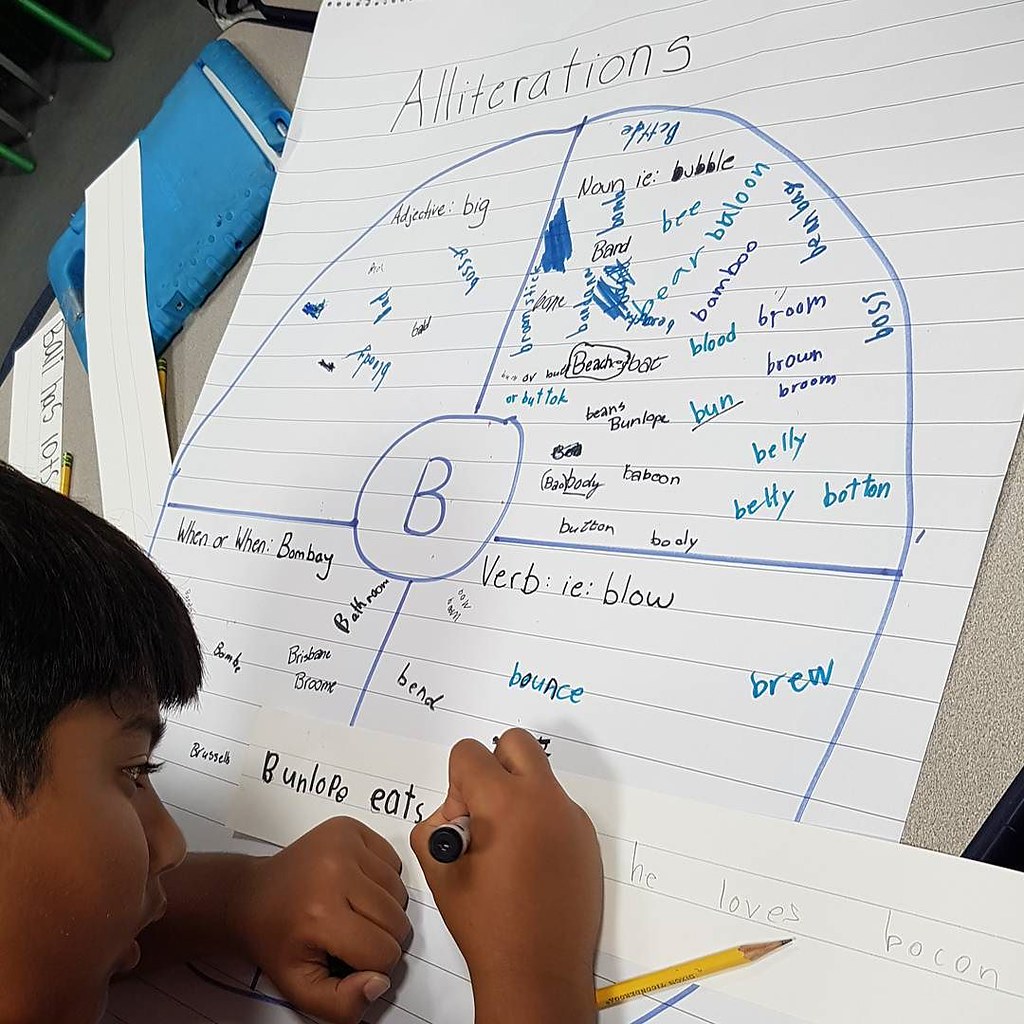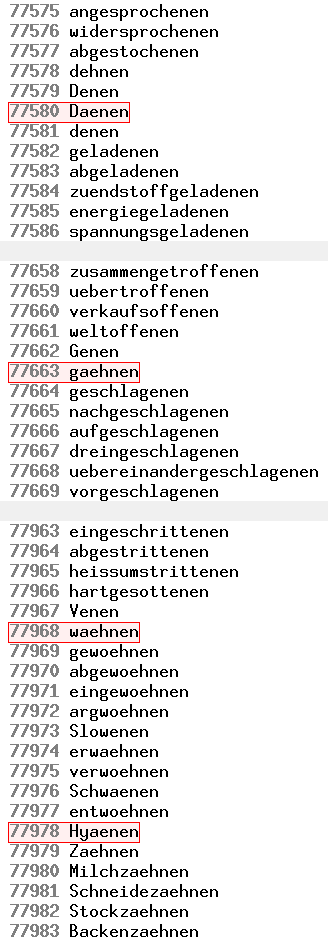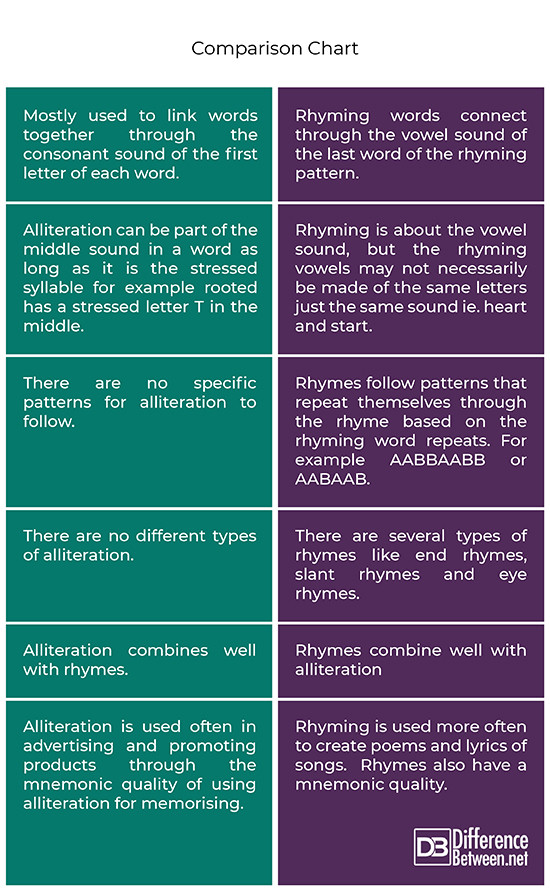Difference between Alliteration and Rhyming
Alliteration and rhyming are two literary tools used to enhance the written word. Their value lies in the sound and resonance they bring to poetry and prose. Alliteration and rhyming create a rhythm and aural quality to a piece of writing that make it pleasing to the ear. Alliteration is focused on the use of consonants while rhyming makes more use of the vowel sounds in words. Together both these literary tools add a particular quality of sound and rhyme to be used by writers. Poems, rhymes and sonnets are prime examples of written works using alliteration and rhyming words.

What is Alliteration?
In simple terms, alliteration is the repetitive use of words starting with the same letter. The sound of the letter links the words together creating a relationship between the words based on their consonant sound. Alliteration is also known as the ‘head rhyme’ or the initial rhyme. The sound that is emphasised through alliteration is not always the first letter sound. Alliteration is created through the first stressed consonant sound and this may be in the middle of a word. The pattern will be a complete link between the sound of a letter that is the same, and that sound will make the pattern known as alliteration.
In this sentence the sound of letter T is heard at the beginning and middle of some words.
‘The tough tree tilted, bent and uprooted, then toppled towards the town.’
Alliteration is closely linked to consonance. The sound of the repeated letter is the consonant that is in the stressed syllable of the word. The quote above has the T in uprooTed as the stress syllable and it is not the first consonant of the word.
Alliteration comes from the Latin word latira meaning letters of the alphabet. The letters are usually part of a series of words, following one another, in a sentence. It is the consonant sound that creates the alliteration. The words ‘not and knotty’ are an example of this aspect of alliteration.
How is alliteration used in literary circles?
Alliteration creates a musical effect, a link between sounds, that make reading poetry and other literary pieces easy on the ear. It is this musical effect that psychologists and discourse analysts say help to activate a reader’s memory. Alliteration improves the reading aloud quality of a poem or rhyme because of the sound connection.
Alliteration is the key factor used in making up tongue twisters and children’s rhymes. The repeating of the same sound is referred to as a mnemonic device by psychologists. It is a recognised learning tool and a way to remember things. Acronyms, alliteration, rhymes and imagery all fall under the umbrella of mnemonic devices. Alliteration brings about a clever association of sound and name and is used widely in advertising. Think of Coco Cola, Dunking Doughnuts, and PayPal. All these brand names make use of alliteration. Famous names with the same sounding consonants like Ronald Reagan, Mickey Mouse and William Wordsworth are easier to remember with the alliteration associated with their names.

What is Rhyming?
The art of rhyming is based on using words that sound the same due to the similarity in the vowel sounds of the word. There are different types of rhyme. The most familiar is known as the ‘end rhyme’ because the rhyming word falls at the end of the sentence or line of poetry. Rhymes have been around for a long time. They made story telling easier before books were available. The story teller could remember the story better if it was written in rhyme. Shakespeare’s sonnets are typical of rhymes from the earlier stages of literature. Sonnets are based on rhyming couplets when lines rhyme in twos. Rhymes, because of the sounds they represent, make verses easier to remember. They are used in early learning circles to teach concepts and increase vocabulary for young children. The art of rhyming is more complex than alliteration and there are many variations in the use of rhyming words especially in more modern poetry.
How is Rhyming used in literary circles?
Rhyming is based on using words with similar vowel sounds to match together and sound the same at the end of the lines in a poem or verse. Rhymes have different basic patterns and do not always work in rhyming couplets like traditional poems did. Rhymes have schemes and these are their patterns or a sequence of letters that make up the pattern to be followed. For example a sequence pattern could be planned like this, AABBCC this would mean two lines rhyme throughout the poem. AAAAA would mean all the lines rhyme and ABAC would mean only the alternate lines rhyme. There are many different patterns and combinations that can be made up to complete a rhyme. Modern poetry may even exclude regular rhyming and rap music often has lyrics that rhyme internally.
There are different types of rhymes as well as the different patterns.
- The end rhyme is the basic rhyme when the last word of the line rhymes with another last word according to the rhyming pattern.
- Internal rhyming is when words rhyme within a line of poetry.
- Slant rhymes are not perfect rhyming words and may just share a vowel sound like star/heart. It is the ‘ar’ sound that comes through the sound of the word.
- Rich rhymes are homophones as well as rhyming words. For example Raise/raze.
- Eye rhymes look the same, but are pronounced differently. For example bough/rough. They will catch the eye in a poem.
- Identical rhymes use the exact same word for the rhyming process.
Sonnets are great examples of rhyming and Shakespeare, in his Sonnet 18 for example shows the use of rhyming in the traditional rhyming couplet. He uses end rhyme as well as eye rhymes with the words date and temperate. If temperate is pronounced with emphasis on the ate syllable the rhyme is complete, but not everyone pronounces temperate in this way and then the word becomes more of an eye rhyme.
Sonnet 18.
Shall I compare thee to a summer’s day?
Thou art more lovely and temperate.
Rough winds to shake the darling buds of May,
And summer’s lease has all too short a date.
What are the benefits of using Alliteration and Rhyming in poetry and prose?
Alliteration and rhyming bring a musical resonance to the poem or piece of prose they become part of. They have the effect of helping people remember things and to enjoy listening to or reading a poem. Songs rhymes and jingles are easier to learn and often alliteration is used in advertising to help listeners connect with a product. Alliteration and rhyming can be used side by side and have twice the effect in a poem or piece of prose.
In Samuel Taylor Coleridge’s poem, The Rime of the Ancient Mariner, there is a very clever use of both rhyme and alliteration.
‘The fair breeze blew, the white foam flew
The furrow followed free;
We were the first that ever burst
Into that silent sea.
When both forms of literary device are used together it is easier to see the difference between the two.
Alliteration Vs. Rhyming

Rhyming and alliteration work together to bring the ‘musical’ quality to poetry and prose. Although they have their differences their purpose is similar. They add quality to the written word. The use of alliteration or rhyming makes a passage of writing easier to read for enjoyment. Although they have different attributes and patterns of usage they have a common purpose and are available for the writer to add quality and sound patterns to their work.
- Difference Between Lagoon and Bay - October 20, 2021
- Difference Between Futurism and Preterism - August 12, 2021
- Difference Between Dichotomy and Paradox - August 7, 2021
Search DifferenceBetween.net :
Leave a Response
References :
[0]Image credit: https://live.staticflickr.com/1612/26537885615_91a1daf819_b.jpg
[1]Image credit: https://upload.wikimedia.org/wikipedia/commons/f/f1/Excerpt_from_a_german_rhyming_dictionary.gif
[2]Niesen. G. The difference between Rhyme and alliteration. Www.wisegeek.com/what-is-the-difference-between-rhyme-and-alliteration.7/02/2020 pub. Conjecture Corporation.
[3]Writer’s block. The Poetry Voice. Rhyme Alliteration and assonance. Www.poetrypotion.com Feb 19th 2012. Pub. Black Letter media (pty) Ltd.
[4]Cummins Kevin Alliteration. Www.slideshare.net May 13th 2012 Linked in Learning.
